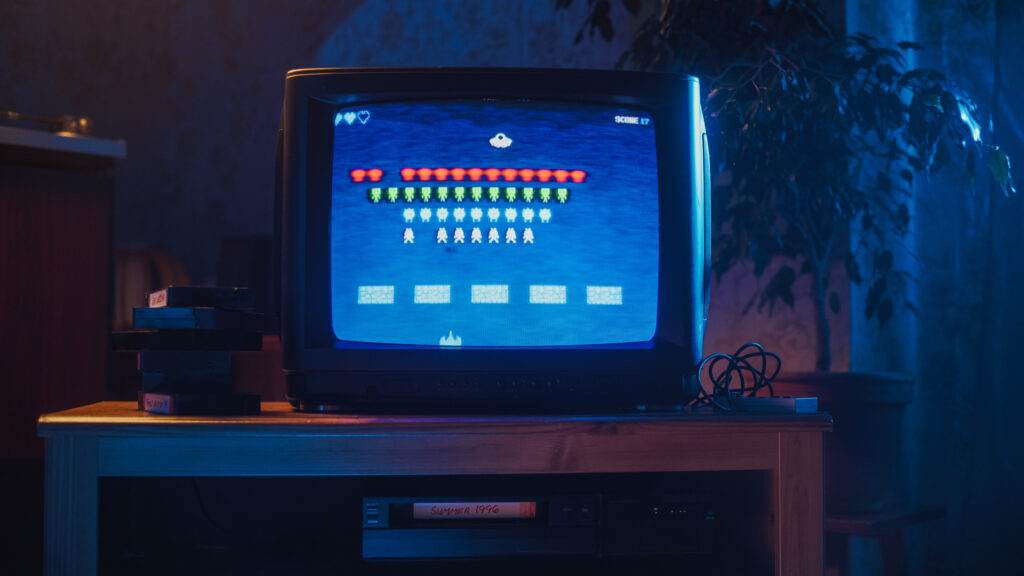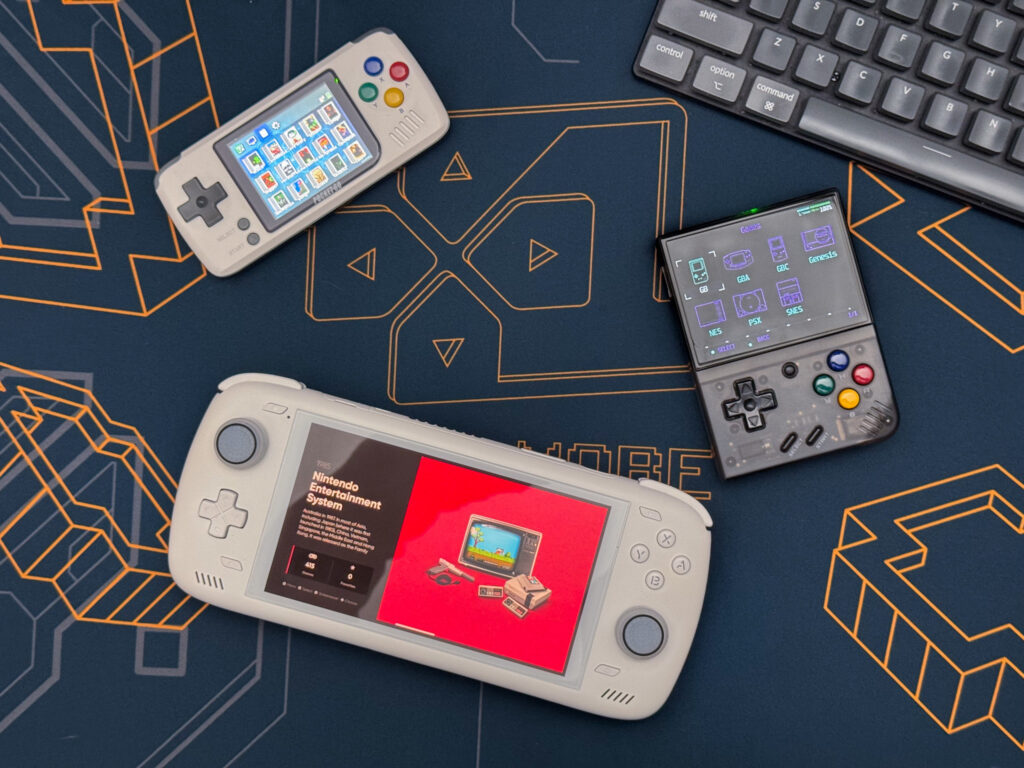
It’s Friday afternoon, and you step off the school bus with a sense of excitement. Your backpack feels lighter than ever, filled not with books and assignments – but the weightless anticipation of the weekend ahead. Anxiously awaiting your to visit to the local video store.
Entering the store, you’re hit by the hum and dull radiance of the overhead fluorescent lights. You make a break straight for the game section. Browsing the rows of boxes with colorful artwork promising worlds of adventure and challenges waiting to be conquered. The selection is slim, so you scan the shelves carefully, examining the back covers, imagining the worlds within each one.
You finally settle on a game you know little about, but one that feels right. Soon, you’re back home, plugging the cartridge into your console. The tv screen glows to life with its warm, flickering light. It casts a familiar glow in the dim room as the game’s title screen fades in.
There’s no rush, no limits; you settle in, wrapped in the freedom to play as much as you want. Hours melt away, replaced by new quests, and the thrilling sense of discovery that only comes from uncovering something unknown.
When Monday arrives, you return to school, exhausted but exhilarated. At lunch, you eagerly recount every detail to your friends. You can feel that shared excitement in their eyes as they listen. They grow eager for their own chance to take on the adventure. It’s a weekend well-spent.
Even as the week stretches on, you know another Friday, and another adventure, is just around the corner.
Each year, we see a wave of retro gaming devices, remastered and remade titles from AAA studios, and indie games tapping into the feelings those old games gave us. What makes nostalgia and gaming such a powerful combination? Something that can transport us back in time and simultaneously drive us to buy a game for the third (or more) time? As gamers (and their wallets) age with the hobby, there’s a constant pull towards the familiar.
The Emotional Pull of Nostalgia

It helps to first understand what nostalgia is. More than a fond recollection; it can be an emotional anchor that ties us to the memories and experiences we cherish. Many of these memories are connected to childhood, a period of simpler, joyful times evoking positive emotions.
Classic games become a comforting retreat, reminding us of the thrill of discovering new worlds or spending hours with friends on shared adventures. Returning to these games provides a sense of continuity and connection with our younger selves. It sparks feelings of happiness and relaxation as we revisit characters, music, and mechanics that once thrilled us.
The Appeal of Simplicity in Classic Games
Many classic games stand the test of time because they embody the principle that “less is more.” They often have simpler mechanics and visuals that make them approachable and instantly enjoyable. Titles like Super Mario Bros., Tetris, and Pac-Man remain beloved because they focus on core gameplay, requiring skill and timing without overwhelming players.
Modern games, although impressive, are often complex and require a time commitment that not every player can afford. Classic games deliver enjoyment with limited buttons, demonstrating a design elegance that appeals across generations and makes them timeless.
Indie Developers Leveraging Retro Aesthetics and Gameplay
Many indie developers have embraced nostalgia, making use of retro aesthetics and gameplay to capture the charm and simplicity of classic games. They will often draw inspiration from the pixelated graphics, chiptune music, and mechanics common in 8-bit and 16-bit games of the past. Indie developers create a bridge between new audiences and gaming’s early eras, reviving the style and design philosophy defining those generations.

Games like Celeste, Shovel Knight, and Undertale are examples of how effective this approach can be. These games prioritize gameplay fundamentals and pixel-art aesthetic reminiscent of classic platforms, appealing to older players and new fans. Unlike many AAA titles that rely on hyper-realistic graphics and expansive worlds, retro-inspired indie games often focus on creative storytelling, unique characters, and challenging gameplay, making them stand out in a crowded market.
For Lasso Games, we leaned into retro aesthetics early on not just because they look and sound cool (though we totally think they do) but because they let us tell stories and design gameplay that feels kinda timeless.
Jack Daniels, Lasso Games
Indie developers can sometimes lean to the retro approach because of the limited budgets and smaller teams typical of indie studios. They can then deliver a polished experience without requiring the resources needed for AAA games. This not only keeps development manageable but allows developers to put a strong focus on storytelling and innovation within a familiar framework.
These nostalgic indie games have carved out a substantial niche. They attract fans of classic gaming while keeping these styles and mechanics relevant in the modern era. They are working to ensure that retro gaming isn’t just a thing of the past—it’s a meaningful part of today’s gaming landscape.
Retro Gaming Devices and Hardware Resurgence

When it comes to playing these classic games, there is no doubt that emulation is king. The barrier is much lower – for both the hardware and the games – but there is something to be said about having that NES Classic on your shelf or entertainment stand.
Its obvious with the release of the NES Classic, SNES Classic, SEGA Genesis Classic, Playstation 1 Classic, and more there is a market. These devices are fueled by nostalgia, offering the physical, collectible aspect, giving players a tangible piece of their gaming past.
Emulation on the other hand makes classic titles accessible on newer and portable hardware, ensuring these games are never far from reach. Partner that with the numerous front-end options (like Emulation Station) to sort and navigate those games, and you have everything you could ever want.
The only drawback to emulation is the space is is currently overcrowded with devices. Companies like Retroid feel like they are pumping out a new device every few months – and forget checking thousands of knockoffs on Amazon. Luckily the space has people like Retro Game Corps to help wade through the countless options.
The Role of Game Remakes and Re-Releases
With the surge of game remakes, remasters, and re-releases, classic titles have found new life in the gaming market. Remakes like Final Fantasy VII Remake and Resident Evil 2 preserve beloved narratives while refreshing graphics and gameplay for today’s standards, bridging generations of players.
By updating older games, developers want to honor the original experience while making it accessible to new audiences. This helps to preserve gaming history and keep nostalgic players engaged with their favorite franchises.
Nostalgia’s Influence on Gaming Markets
Nostalgia isn’t just a personal journey; it’s a significant collective market force. Retro-inspired games, accessories, and re-releases are booming, as are games that tap into classic mechanics or aesthetics. Companies recognize the demand for nostalgia-driven products and frequently revive beloved franchises to capitalize on this trend. Creating cross-generational appeal broadens the market, as parents introduce their children to the games they grew up with. Nostalgia’s market impact is clear.
Conclusion
Nostalgia’s influence on gaming is powerful and far-reaching, creating a lasting bond between players and their favorite titles. Classic games offer comfort, simplicity, and a sense of continuity, making them a popular escape and a consistent market force. As nostalgia continues to shape the industry, we can expect to see more remakes, retro devices, and inspired re-releases that honor gaming history and keep these memories alive. What classic games do you hold close, and what memories keep bringing you back?
- 1 Comment
- Gamer Talk
- November 20, 2024


Thanks for taking the time to discuss this with me, what a great topic!